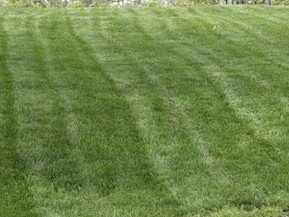Introduction to
Cool Season Grass
Growth and Maintenance

The name "Cool Season Grass" is given to a variety of grass species that thrive best in cooler temperatures and particularly in the cooler regions of the country from the central transition zone and throughout the northern U.S.
The summer temperatures in southern states are generally too hot to successfully grow most varieties of cool season grasses. The transition zone is so named because of the blending and crossover from cool to warm season grasses. Click here to see the U.S. Climate Zones of Grass Adaptation.
Notice that the grass adaptation zones are categorized differently from the USDA Plant Hardiness Zones.
Cool season grasses include forage and range grasses, ornamental grasses, turf grasses, and
even cool season grassy weeds. Grass seeds are planted in the fall and will thrive best
in temperatures between 65 and 75 degrees. In contrast, warm season
grass seeds are planted in the spring and grow best in the warmest
months.
Varieties of Cool Season Grasses
Cool season turfgrasses include bluegrasses, fescues, and ryegrasses. The turf varieties of these grasses have blade textures and color that make a beautiful lawn.
Popular forage grasses include orchardgrass, timothy, fescue, ryegrass, and brome. These forage grasses can also be found in lawns, but are usually considered a weed. Tall fescue grass and the ryegrasses have forage varieties that are much larger plants and do not have the same quality as the turf-type varieties.
Each of the turf grasses have different characteristics that separate them from other grasses. The most noticeable is its color. However, blade width, growth habits, turf density, and its ability to withstand heavy traffic are also important. Most can withstand harsh winters and a few are able to survive longer periods of hot, humid weather. If you live in a cooler part of the country, there is a grass type that will work well for you.
Cool season varieties can be started from seed much easier than most warm season grasses and the seed is generally much less expensive. Bluegrass seed and rye grass seed are among the least expensive.
For detailed information on these popular grasses and the best ways to care for them, click on the links below.
Detailed Information on Kentucky Bluegrass and Other varieties
Kentucky bluegrass is one of the most popular of all grass types. It
is used on lawns, fairways and athletic fields in the cooler areas of
the U.S. Find out what makes this grass so special.
Coarse and Turf-Type Tall Fescue
Tall fescue is an exceptional cool season grass. It is preferred by
many because of its dark green color, wear resistance and heat
tolerance. It is important to choose the right type depending on the
look you want. Click here to find out everything you need to know about
coarse and turf-type tall fescue.
Annual and Perennial Ryegrass
Ryegrass has come a long way with the introduction of new turf
species. See all the pros and cons about using the perennial and annual
varieties.
Fine Fescue Grass
The fine fescue grasses are known for their exceptional shade and
cold tolerance. They have some of the narrowest blades of any grass
type. Click here for detailed information about its climate range, uses
and management.
Detailed Tips and Techniques for Overseeding Lawns
Overseeding Lawns is one of the most overlooked practices by
homeowners. However, it is one of the most important steps you can take
to maintain a consistently thick and beautiful lawn. Find complete
information on why and how to overseed correctly.
Plant Growth Regulators
Plant Growth Regulators are just beginning to be discovered by
homeowners. They are fantastic products with dozens of uses for
everything from slowing grass growth to eliminating unwanted tree fruit.
Click here to discover what you have been missing.
Watering a New Lawn
Watering a new lawn is very different from watering a mature lawn.
When planting a new lawn, success will be greatly increased by learning
proper watering techniques.
Lawn Winterization Tips and Techiques
Fall winterization is the most important time for fertilizing cool
season grasses. Warm season grasses do not receive the same treatment.
Find everything you need to know to winterize both cool and warm season
grasses.
Developing a Lawn Fertility Program
Behind every beautiful lawn is a good lawn fertilization program.
Whether it's a championship golf course or your home lawn, certain
fundamentals always apply. Click here to begin planning your
fertilization program.
Plant Structure and Grass Growth
In the world of turf grass, understanding plant structure and growth
can provide helpful insights to maintaining a beautiful lawn.
Understanding Photosynthesis
Photosynthesis made easy! Understanding basic plant function will
greatly improve your lawn care, especially fertilization. You will never
look at your grass the same way.
Cool Season Grass Cultivars
Many grass types have numerous varieties to choose from. Click here to see the "cool season grass" cultivars that are available.
Warm Season Grass Cultivars
Great improvement has been made with warm season grass varieties. Click here for a list of "warm season grass" cultivars.
Lawn Moss and How to Control it
Lawn moss is a common problem in yards. However, its presence
represents deeper soil problems that must be fixed or the moss will
stick around. Find out what must be done to finally end your moss
problems.
Dog Urine Damage on Lawns
We all love our pets, but dog urine can do a number on grass. There
is hope. Find out what can be done to save your lawn and your pet too.
Share This page:

